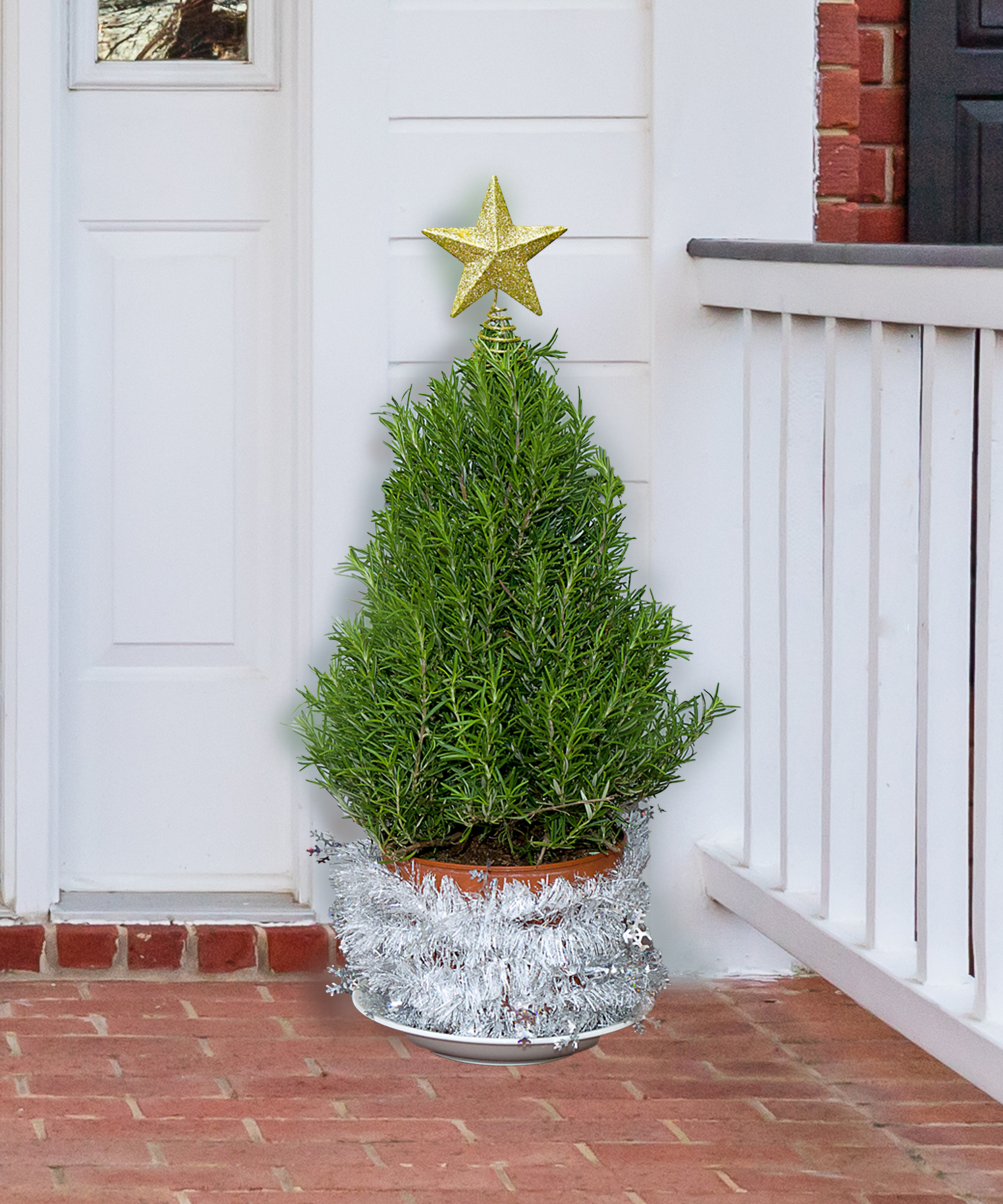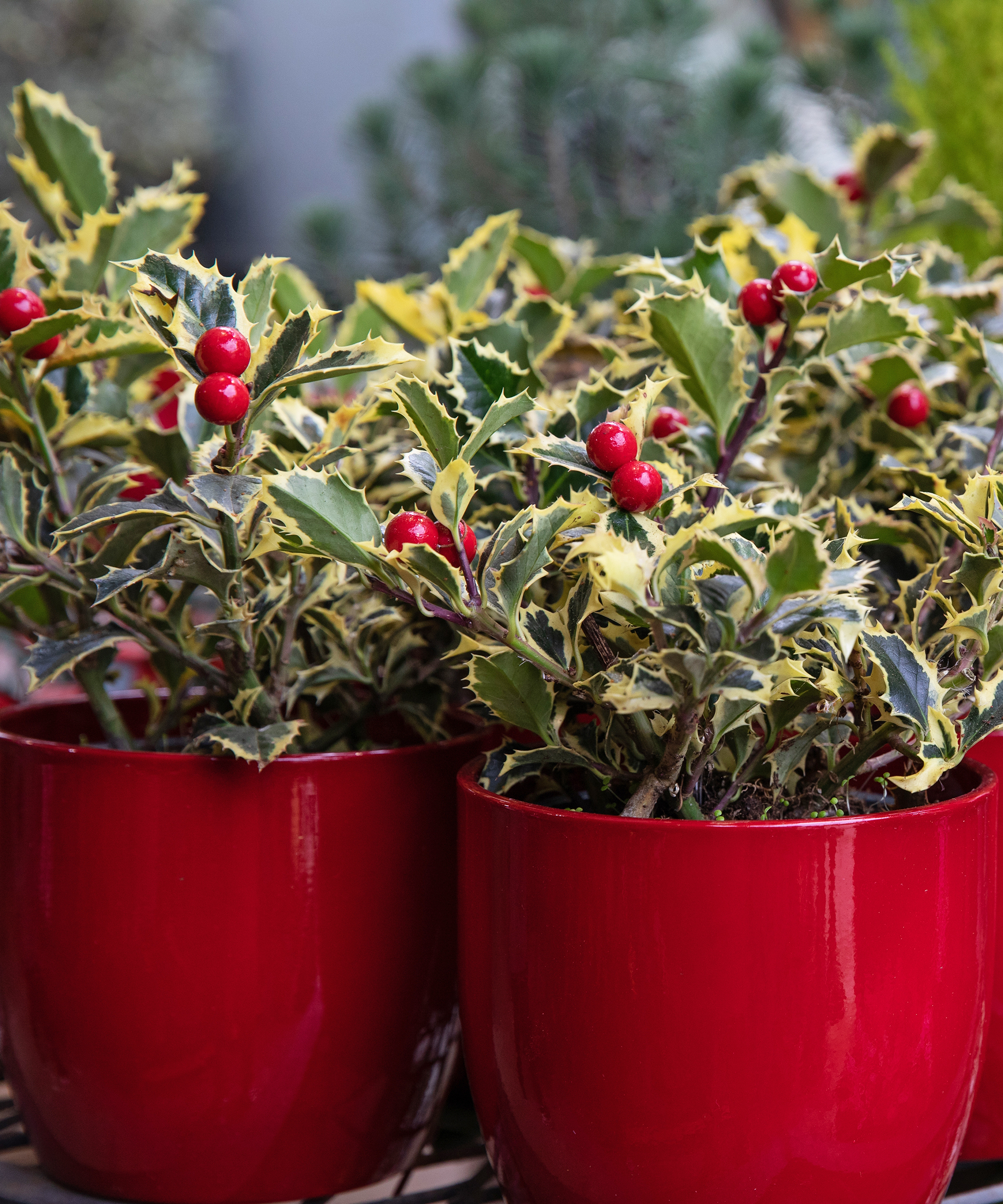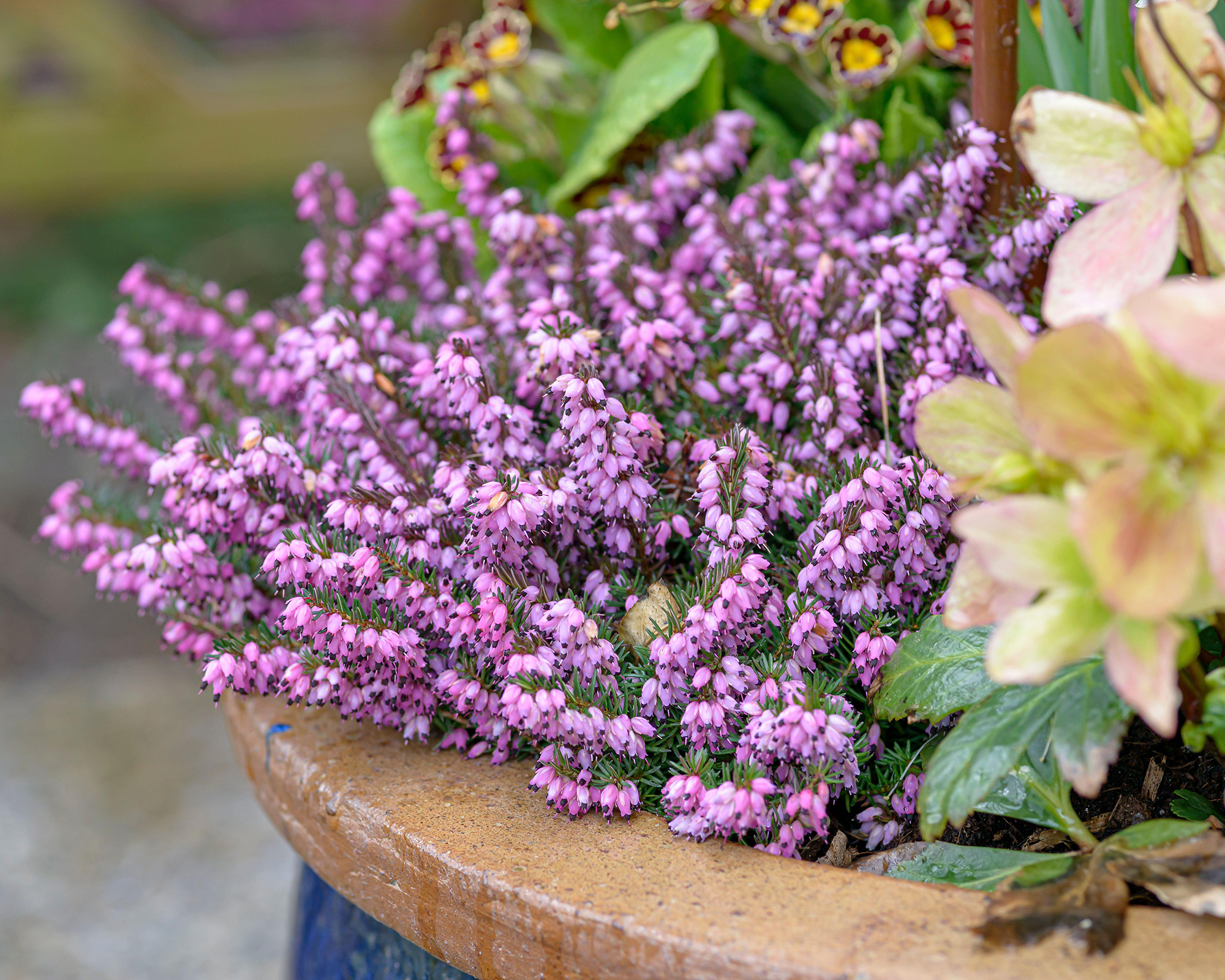DIY Holiday Porch Pot Ideas: 12 Perfect Plants For A Magical Winter Display
Make a charming holiday porch pot to take you through the festive season and beyond, filled with lustrous foliage, vibrant berries, and cheerful flowers.


Amy Draiss
A beautiful holiday porch pot, brimming with seasonal plants that celebrate the winter months, is a wonderful way to bring festive charm to your doorstep.
Whether you envision a classic arrangement with evergreen foliage reminiscent of Christmas trees, or a lively mix of bright berries and textured branches, making a holiday porch pot offers a creative outlet to express your seasonal spirit and add a warm welcome for guests. A festive porch pot is also a unique host or hostess gift idea for all your holiday fêtes this season.
How to Make Evergreen Holiday Porch Pots
When choosing plants for holiday porch pots, think about both style and durability. Hardy evergreens and berry-bearing shrubs can withstand the chill and make ideal winter container plants, while in certain USDA hardiness zones, there are flowering perennials that will thrive outdoors through winter. Alternatively, if you have an enclosed porch, consider planting a pot with more tender seasonal varieties.
If you want to plant more than one variety in a pot, use the professional design trick of thriller, filler, spiller. Choose a statement centerpiece "thriller" plant, add smaller "filler" plants to make the arrangement look fuller, and "spiller" plants that cascade over the side.
Equally important is selecting the right container – choose sturdy, weather-resistant pots in colors that complement your home’s décor. Winterize pots to protect your display from extreme weather, adding insulation and raising them off the ground.
Design your own holiday porch pot with these plants that capture the charm of the season. Or, if you're ready to get planting, find everything from vibernum to seasonal amaryllis in our selection of essential winter plants in the Gardening Know How Shop.
1. Dwarf Alberta Spruce

If you're looking for the perfect mini Christmas tree to display in your porch pot, then look no further than the dwarf Alberta spruce, available in the Gardening Know How Shop. A type of white spruce with a compact growth habit, it possesses blue-green needle-like foliage and a pleasing full cone shape that looks magical when decorated for the holidays.
Sign up for the Gardening Know How newsletter today and receive a free copy of our e-book "How to Grow Delicious Tomatoes".
With a very slow growth rate of 2 to 4 inches (5-10cm) per year, Alberta spruce – or Picea glauca 'Conica' – can be kept to a container size with an occasional trim, meaning you can enjoy it as a porch pot year after year. If you choose to plant it in the garden, it requires minimal maintenance and almost no pruning.
Alberta spruce is a North American native that can be grown in USDA zones 3 to 6. While you can keep the tree in a sheltered porch area over the holidays, it should be moved to a full-sun spot for the rest of the year.
2. Hellebores

Also known as Christmas roses, hellebores are some of the earliest bloomers in the garden, bursting forth in late winter. However, some varieties bloom in December, such as ‘Snowbells’ and ‘Walberton's Rosemary’, while others appear as early as November, including ‘Praecox’ and ‘Jacob’. Praecox is a particularly early bloomer, making it perfect for holiday porch pots that will take you from Thanksgiving through to spring.
Hellebores thrive in spots with some dappled light in moist, well-draining soil that is rich in nutrients. They are broadly suitable for USDA zones 3-9, but double-check your chosen variety if you live at either end of this scale.
Growing hellebores in containers is easy over the holidays, but long-term they will need a large pot with rich potting soil or should be planted out in garden beds.
3. Amaryllis

Amaryllis are icons of the holiday season. Though usually reserved for indoors at this time of year, they may be used as part of a porch pot display when positioned inside a warm enclosed porch – ideally between 60-65°F (15-18°C).
Widely seen in festive ruby red, amaryllis flowers also come in shades of pink, orange, and white – browse our seasonal pick of amaryllis in the Gardening Know How Shop. The plants' joyful large blooms sit atop tall slender stems that make them a stunning centerpiece.
Amaryllis are forced to bloom over the holidays, but naturally, they flower in the springtime. If you live in USDA zones 8-11, you can plant your bulbs in the garden, once the blooms have faded, to enjoy a reappearance every spring.
Other holiday plants that can be enjoyed as part of an enclosed porch display include poinsettias, Christmas cactus and Thanksgiving cactus plants, and cyclamen. Indeed, these plants can all thrive in a protected space that is a few degrees cooler than the main living spaces.
4. Rosemary

Rosemary makes a delightfully fragrant mini Christmas tree to provide a warm welcome to guests over the holiday season. Its foliage also makes a delicious addition to festive cocktails and roast dishes – but avoid getting too snip-happy as the plant won’t grow much over winter.
To grow a rosemary Christmas tree, you will need to prune it into a conical shape, which you can then decorate with ribbons and small ornaments.
It’s easy to grow rosemary in containers – plant in well-draining soil, position in a full-sun spot, and water every week or two. In the summer, plants will produce flowers that are beloved by pollinators. There are varieties suitable for zones 6-11.
5. Holly

It wouldn’t be the holidays without holly (Ilex spp.), and this diverse plant group has plenty of choice for porch pots. While some of the larger varieties can’t stay in a pot for too long, more compact hollies, such as dwarf Japanese holly, can be kept in pots and pruned as topiary specimens long term.
If you opt for a larger variety, move it to the garden after a couple of years and forage its greenery for making wreaths and porch pot displays.
Blue holly is a stunning choice for festive arrangements – try 'Honey Maid' holly, available in the Gardening Know How Shop, a type of blue holly with striking variegated leaves.
While its lustrous leaves are a given, holly won’t produce its trademark berries without a male pollinating partner, so if this is important to you, check that you have both male and female plants.
There are types of holly that will grow as far north as zone 3, and as warm as zone 11, so choose a type compatible for your region. Most require a full sun spot and moist but well-draining soil.
6. Juniper

Junipers are slow-growing evergreen conifers that make stunning Christmas porch pot plants. Though taller varieties can eventually reach more than 30 feet (9m), compact junipers may never exceed 5 feet (1.5m), making them ideal for container growing – particularly the more columnar or pyramid forms.
'Gold Cone', available in the Gardening Know How Shop, is a beautiful choice for a mini tree, possessing a natural golden color.
With fragrant foliage that smells very fresh, junipers will really set the scene for your home over the holiday season. Female plants also produce festive berries or cones – though they require a male pollinating partner.
Junipers are low-maintenance, hardy, and drought-tolerant. They are suitable for USDA zones 2-9, rarely require pruning, and can thrive in any soil type as long as it is well-draining. Position plants in full sun or light shade.
7. Winter Heather

Winter heather (Erica carnea) is a low-growing shrub with flowers in shades of purple through magenta and white. Normally it flowers in late winter and spring, but some varieties bloom as early as November and December, making them perfect for holiday porch pots. Try ‘December Red’, ‘Winter Beauty’, and ‘King George’.
These varieties not only provide color and interest in winter, but also provide essential sustenance for dwindling pollinators at a time of year when food is scarce.
Winter heather can be grown in USDA zones 4-7, and should be planted in well-draining soil in a sunny spot.
8. False Holly

Often called false holly or holly olive, Osmanthus heterophyllus has spiny, beautifully patterned leaves often likened to holly. Between late summer to fall, the plant is covered with clusters of fragrant white flowers that give way to jewel-like blue-black berries that should persist through the holiday season.
Goshiki false holly, available in a holiday pot in the Gardening Know How Shop, is a popular variety due to its dense pyramid shape and gold-flecked variegated foliage.
False holly is slow-growing but will need to be lightly trimmed each year to keep it to holiday porch pot size, or planted in the garden where it will eventually reach a size of 4-8 feet (1.2-2.4m), depending on the variety. It’s hardy in USDA zones 7-9, but can occasionally thrive in zone 6 with some winter protection.
Position false holly in full sun or partial shade, in well-draining acid-to-neutral soil.
9. Red Twig Dogwood

With its striking red branches, red twig dogwood (Cornus sericea) is a more unusual choice that raises the wow factor of holiday porch pots. Browse our pick of Cornus sericea available in the Gardening Know How Shop.
Bear in mind that this variety is best grown in pots only when young, before being planted out in the garden to accommodate a spread of up to 8 feet (2.5m). Once established, you can cut individual stems to elevate floral displays, porch pots, and wreaths.
The brilliant winter red stems are green and leafy in spring and summer, producing creamy white flowers that give way to white berries before the plant sheds its foliage in the fall.
Red twig dogwood can be grown in USDA zones 2-7 in moist soil in partial shade to full sun. Aside from a good annual pruning to remove old faded stems, it requires minimal care.
10. Winter Pansies

Is there a cheerier sight on a dark winter’s day than a porch pot filled with winter pansies (Viola hiemalis)? These cold-tolerant marvels belie their delicate appearance, soldiering on in near-freezing temperatures.
However, while in zones 7-11, winter pansies can bloom continuously through winter, in cooler zones 4-6, they will go dormant when temperatures plummet. If you experience cold snaps of 25°F (-4°C) or lower, move your porch pot to a more sheltered spot until it passes, or pile on some pine straw mulch.
Pansies thrive in nutrient-rich soil in full sun to partial shade. Avoid letting the soil dry out, and deadhead blooms to keep them flowering through spring.
11. Christmas Wintergreen

A low-growing evergreen shrub, Christmas wintergreen (Gaultheria procumbens) is often used for groundcover but looks fabulous grown in a holiday porch pot. Its slow growth rate means it can stay in the same pot for several years.
Christmas wintergreen is available in the Gardening Know How Shop, supplied in a pretty holiday pot. With glossy foliage that turns red to bronze in winter, wintergreen is brimming with seasonal color. It also produces white flowers in the summer followed by gorgeous red berries that persist into winter.
Wintergreen is native to forests and so thrives in light to full shade in moist acidic soils. It is suitable for USDA zones 3-8.
12. Inkberry

Inkberry (Ilex glabra) is a type of holly with dark ink-colored berries and smooth leaves that give it a very different appearance from traditional holly. It comes in a range of sizes, from diminutive 4-foot (1m) varieties that make ideal porch pot candidates, to 8-foot (2m) giants destined for being planted in borders or as hedges.
While inkberry is easy to look after, it is prone to spreading in gardens through root suckers, so remove these regularly to prevent it from taking over. However, some varieties, such as Shamrock, available in the Gardening Know How Shop, are less prone to this issue.
As with other types of holly, inkberry requires both male and female plants to produce berries.
Plant inkberry in a full sun spot in moist well-draining acidic soil. It thrives in USDA zones 4-10.
This article features products available from third-party vendors on the Gardening Know How Shop.

Melanie is an experienced gardener and has worked in homes and gardens media for over 20 years. She previously served as Editor on Period Living magazine, and worked for Homes & Gardens, Gardening Etc, Real Homes, and Homebuilding & Renovating. Melanie has spent the last few years transforming her own garden, which is constantly evolving as a work in progress. She is also a passionate organic home grower, having experimented with almost every type of vegetable at some point. In her home, Melanie tends to an extensive houseplant collection and is particularly fond of orchids.
- Amy DraissDigital Community Manager
